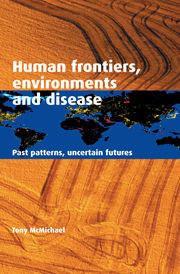Book contents
- Frontmatter
- Contents
- List of sources for illustrations
- Preface
- 1 Disease patterns in human biohistory
- 2 Human biology: the Pleistocene inheritance
- 3 Adapting to diversity: climate, food and infection
- 4 Infectious disease: humans and microbes coevolving
- 5 The Third Horseman: food, farming and famines
- 6 The industrial era: the Fifth Horseman?
- 7 Longer lives and lower birth rates
- 8 Modern affluence: lands of milk and honey
- 9 Cities, social environments and synapses
- 10 Global environmental change: overstepping limits
- 11 Health and disease: an ecological perspective
- 12 Footprints to the future: treading less heavily
- Notes
- Index
12 - Footprints to the future: treading less heavily
Published online by Cambridge University Press: 05 March 2012
- Frontmatter
- Contents
- List of sources for illustrations
- Preface
- 1 Disease patterns in human biohistory
- 2 Human biology: the Pleistocene inheritance
- 3 Adapting to diversity: climate, food and infection
- 4 Infectious disease: humans and microbes coevolving
- 5 The Third Horseman: food, farming and famines
- 6 The industrial era: the Fifth Horseman?
- 7 Longer lives and lower birth rates
- 8 Modern affluence: lands of milk and honey
- 9 Cities, social environments and synapses
- 10 Global environmental change: overstepping limits
- 11 Health and disease: an ecological perspective
- 12 Footprints to the future: treading less heavily
- Notes
- Index
Summary
Few ape species survived the prolonged period of climatic cooling and environmental change that began in the Miocene around 15–20 million years ago. Today there are just the orangutans, gorillas, chimpanzees and humans. The three non-human ape species are being rapidly depleted as the human population expands its numbers and intensifies its activities. That fourth ape species, Homo sapiens, is in many ways a product of the unusually cold world over the past several million years.
Five million years ago, a bipedal hominid with short legs and long arms shuffled out of the receding forest, and managed to survive by foraging for plant foods in the thinning woodland and by occasionally scavenging meat or killing small animals. That hominid's descendants, much later, used stone tools and fire, and acquired the ability to share ideas and plans. This was a larger-brained, meat-eating species that lived primarily on its wits, possessing neither brawn nor specialised anaomil armoury. Indeed, as hunter-gatherers, humans are distinguished by their non-specialisation; they can survive, opportunistically, eating a mix of plant foods and animal species. They could hunt a local population to the point of extinction, and then switch to another species. In this way, they probably contributed to the extinction of many of the megafauna soon after the end of the last glaciation, 15,000 years ago. We see the same thing happening today. With our sonar-assisted fishing fleets we over-fish the ocean's great fisheries, switching almost nonchalantly from one prey species to the next.
- Type
- Chapter
- Information
- Human Frontiers, Environments and DiseasePast Patterns, Uncertain Futures, pp. 341 - 365Publisher: Cambridge University PressPrint publication year: 2001



